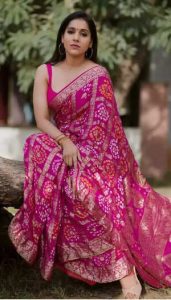Bandej Saree
 Bandhej (also known as Bandhani) sarees are a traditional form of tie-and-dye textile art that originated in the western Indian states of Rajasthan and Gujarat. The name “Bandhej” is derived from the Sanskrit word “bandhna,” which means “to tie.” These sarees are renowned for their vibrant colors, intricate patterns, and exquisite craftsmanship.
Bandhej (also known as Bandhani) sarees are a traditional form of tie-and-dye textile art that originated in the western Indian states of Rajasthan and Gujarat. The name “Bandhej” is derived from the Sanskrit word “bandhna,” which means “to tie.” These sarees are renowned for their vibrant colors, intricate patterns, and exquisite craftsmanship.
Bandhej sarees are made by tying small sections of the fabric with threads before dyeing them. This technique creates beautiful patterns and designs on the fabric, as the tied areas resist the dye. Skilled artisans create intricate designs using various tying methods, resulting in patterns like dots, waves, and squares. Bandhej sarees are known for their bright and eye-catching colors, which reflect the lively culture of the region. These sarees typically feature traditional colors such as red, green, yellow, blue, and purple. The end result is a stunning saree with vibrant colors and unique patterns, making it a popular choice for traditional occasions, festivals, and weddings.
also read about Indian Sarees and Types
History of Bandej Saree
Bandhej sarees’ origins are deeply rooted in the cultural heritage of India, particularly in the states of Gujarat and Rajasthan. Bandhej is probably the oldest known technique of tie & die which was discovered some 5000 years ago and has been practiced in these regions for generations. Bandhani is believed to have originated from the city of Ajrakhpur in Gujarat in the 6th century BC. As per evidence in Historical Texts, the first Bandhani saree was worn at the time of Bana Bhatt’s Harshacharita in a royal marriage. Ajanta walls stand for the evidence of these Bandhani sarees.
Bandhani became popular in Gujarat in the 7th century AD when the Khatri community of skilled dyers and printers started using the technique. The Khatri community remains the main practitioner of Bandhani in India. Fine varieties of Bandhej are created in Pethapur, Mandvi, Bhuj, Anjar, Jamnagar, Jetpur, Porbandar, Rajkot, Udaipur, Jaipur, Ajmer, Bikaner, Churu etc.
Manufacturing of Bandej Saree
The making of Bandhej sarees involves a labor-intensive and intricate tie and dye technique. Skilled artisans carefully execute each step of the process to create the beautiful and vibrant patterns that characterize Bandhej sarees. Here is a detailed overview of the traditional Bandhej-making process:
Selection of Fabric:
To start making a saree, the first step is to choose an appropriate fabric. Typically, cotton and silk fabrics are preferred because they retain color well. The selected fabric is then thoroughly cleaned to eliminate any impurities or sizing agents.
Designing the Pattern:
The artisan plans the design and pattern that will be created on the saree. Depending on the complexity of the design, the tying process can take a considerable amount of time and expertise.
Tying the Fabric:
This is the most crucial step in creating a Bandhejsaree. The fabric is folded multiple times to create several layers, and then small sections are carefully tied with threads. The tying is done in a way that creates various patterns, such as dots, waves, and squares, as per the planned design.
Dyeing Process:
Once the tying is complete, the saree is ready for dyeing. Artisans use natural or synthetic dyes to color the fabric. The tied sections resist the penetration of the dye, resulting in the creation of patterns when the fabric is dyed. The dyed saree is then left to dry in the sun.
Unraveling and Washing:
After the fabric is completely dry, the tied threads are carefully unraveled to reveal the white areas that were protected from the dye. The saree is then washed to remove any excess dye and to make the colors vibrant and even.
Additional Dyeing and Repeating the Process:
In some cases, more complex patterns may require multiple rounds of tying and dyeing to achieve the desired outcome. The process of tying, dyeing, and washing may be repeated several times to achieve intricate patterns and multiple colors.
Finishing Touches:
Once the final design and color are achieved, the saree undergoes finishing touches. The edges are hemmed, and any loose threads are trimmed.
Final Inspection:
The completed Bandhejsaree undergoes a final inspection to ensure that the patterns are consistent and the colors are vibrant and even.
Starching and Ironing:
To enhance the texture and appearance of the saree, it may be starched and ironed to give it a smooth finish.
The entire process of creating a Bandhejsaree is a labor of love and craftsmanship. Each saree is unique, and the beauty of the Bandhej lies in the handcrafted patterns and vibrant colors that reflect the cultural richness of India’s heritage. These sarees are not only worn in India but have also gained international recognition for their artistic beauty and craftsmanship. They continue to be an essential part of the fashion industry and are appreciated by people around the world who value traditional textiles and cultural heritage
also read about Indian Sarees and Types



